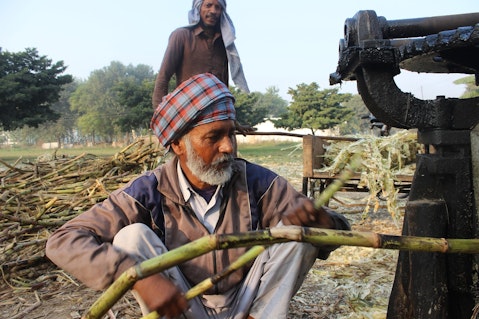In this article, we will discuss countries with the highest yield of sugar and their latest sugar production quantity. If you want to skip our analysis of the global sugar market and its impact on the economies of the world’s biggest sugar producers, read 8 Countries That Produce The Most Sugar.
Brazil, India, and China lead the countries that produce the most sugar; these nations collectively make up 41% of the global production. If we talk about Brazil, its hold in the sugar industry is powered by expansive sugarcane fields and a favorable climate. However, a substantial portion of Brazil’s sugarcane harvest is diverted to ethanol production due to government mandates and global biofuel demand. On the other end of the supply chain, the United Arab Emirates, Brazil, Cuba, and Malaysia are the Countries With The Highest Sugar Consumption.
The white, refined sugar we see comes from either sugar cane or sugar beet, the two sugar crops whose growth determines a country’s ability to produce processed sugar. Sugarcane is native to tropical regions in South Asia and is the world’s largest crop in production, with over 1.966 billion tons produced in the previous crop year. Once cut, the cane stalks are crushed to extract the juice, which is then purified and crystallized to produce raw sugar.
Intriguingly, sugar beet is a root crop that many don’t presume is a source of sugar, but it very much is. Of the 20 countries that produce the most sugar, four heavily rely on sugar beet, namely the United States, Russia, Ukraine, and France, as the crop primarily grows in the cooler climates of the Northern Hemisphere.
Sugarcane is also the most consumed crop in the world, as its global consumption reached 1.966 billion tons in the crop year 2021/2022. Explore 15 Most Consumed Crops in the World to learn more about the most significant crops.
Global Sugar Market Overview
According to a report by MarketsandMarkets, the global sugar market is $46.4 billion in 2023 and is projected to reach $59.1 billion by 2028. The market will grow at a CAGR of 5% between 2023 and 2028, owing to increasing demand for processed food and beverages.
The food and beverage industry is a significant consumer of raw sugar and affects market trends to a great extent. According to the Centers For Disease Control and Prevention (CDC), American youth consumes 143 calories from SSBs (sugar-sweetened beverages) daily, while the consumption is 145 calories for older people. If we talk about average sugar consumption (including beverages, refined sugar, etc.), American adults take 17 teaspoons of added sugar every day, which is 2-3 times higher than the recommended amount as per the American Heart Association.
While refined sugar’s raw calories are associated with obesity and other health issues, it’s imperative for the beverage and processed food industry. For instance, the Coca-Cola Company (NYSE:KO) and PepsiCo, Inc. (NASDAQ:PEP) are two titans of the beverage industry. The global market presence, along with a massive demand for sugar to produce their flagship carbonated drinks, means the purchasing decisions of Coca-Cola Company (NYSE:KO) and PepsiCo, Inc. (NASDAQ:PEP) can significantly impact global sugar prices.
The Coca-Cola Company (NYSE:KO) offers over 500 brands in more than 200 countries and territories. As a major producer of sugar-sweetened beverages, the company’s sugar procurement strategy and demand heavily influence global sugar prices and market trends. Likewise, PepsiCo, Inc. (NASDAQ:PEP) has multiple well-known brands like Pepsi, Mountain Dew, and Gatorade, among many others. So naturally, the company is one of the largest purchasers of sugar in the world.
Apart from the beverage industry, the confectionery industry also heavily relies on raw sugar. Mondelez International Inc. (NASDAQ:MDLZ), the owner company of brands like Cadbury and Oreo, is a big stakeholder in the market. Mondelez International Inc. (NASDAQ:MDLZ) reported net revenues of $31.496 billion in 2022, 9.6% higher than a year before. It’s the well-loved brands like Milka, Trident, and Cadbury that drive Mondelez International Inc. (NASDAQ:MDLZ) ‘s high sugar use.
The biofuel industry, specifically ethanol production, is another off-taker of raw sugar. Brazil, the world’s largest sugar producer, channels a substantial portion of its sugarcane crop into ethanol production. As a result, companies like Archer Daniels Midland Company (NYSE:ADM) are stakeholders in the sugar market. The rising demand for biofuels could stimulate increased sugar production and potentially higher prices.
Let’s now list the top countries in sugar industry.

20 Countries That Produce the Most Sugar
Our Methodology
We ranked the top 20 sugar producing countries according to their raw sugar yield in the crop year 2020/2021. Our source for this study was the Food and Agriculture Organization Of The United Nations (UN FAO). After shortlisting the nations leading in sugar production, we downloaded their raw sugar output stats from the UN FAO database by selecting the indicators of ‘production quantity in 2020’, as these are the latest records available.
Based on our findings, here are the 20 countries that produce the most sugar:
20. Ukraine
Annual Raw Sugar Production: 1.17 million metric tons
Ukraine is a top player in the global sugar market, and beet sugar is the main type produced. The country was estimated to produce approximately 1.17 million metric tons of sugar in the 2020/2021 crop year. A large part of Ukraine’s agricultural sector is devoted to sugar beet cultivation because of its fertile soil conditions and favorable climate. Major regions for sugar beet cultivation include Poltava, Vinnytsia, and Khmelnytskyi.
19. Iran
Annual Raw Sugar Production: 1.56 million metric tons
Iran’s sugar production primarily revolves around two crops: sugar beets and sugarcane. In 2020/21 crop year, the country produced over 1.56 million tonnes of sugar annually. Sugar beets are grown in the country’s colder north, while sugarcane thrives in the hot and humid southern region. Sadly, Iran has been grappling with a water shortage that impacts sugar production.
18. Argentina
Annual Raw Sugar Production: 1.80 million metric tons
Argentina is renowned for its fertile Pampas grassland and has a long history of harvesting sugarcane. As a result, it sits amongst countries that produce the most sugar, with annual production exceeding 1.8 million tonnes. The subtropical provinces of Tucumán, Salta, and Jujuy are Argentina’s main sugarcane cultivation areas, as they benefit from adequate rainfall and warmth. The Argentine sugar industry is heavily mechanized, focusing on producing bioethanol from sugarcane as an alternative energy source.
17. South Africa
Annual Raw Sugar Production: 2.10 million metric tons
South Africa’s sugar industry is predominantly based in KwaZulu-Natal and Mpumalanga provinces. The country ranks amongst 20 countries that produce the most sugar, owing to its around 24,000 registered sugarcane growers. South Africa cultivates about 19-20 million tonnes of sugarcane annually, then processed in 14 mills nationwide. Sugar production provides employment opportunities and facilitates infrastructural development.
16. Indonesia
Annual Raw Sugar Production: 2.123 million metric tons
Indonesia is one of the countries that produce the most sugar. It is also the fifth-largest sugar consumer in Asia; the country’s sugar industry is centered in Java, where the climate favors sugarcane cultivation. However, regardless of its vast cultivation areas, Indonesia’s sugar production is often insufficient to meet its domestic demand as there are inefficiencies in farming and processing.
15. Philippines
Annual Raw Sugar Production: 2.125 million metric tons
In the Philippines, sugar production is a vital industry supporting over five million people directly or indirectly. The country produces an average of 2.12 million metric tons of sugar annually, catering mostly to domestic consumption. The Philippines’ sugar industry also significantly contributes to bioethanol production, as the Biofuels Act of 2006 mandates a minimum bioethanol blend in gasoline.
14. Colombia
Annual Raw Sugar Production: 2.21 million metric tons
Colombia produces approximately 2.2 million tons of sugar per year, and sugarcane is a significant cash crop. Much of this output is used for domestic consumption, while a sizable portion is converted into ethanol for biofuel.
13. Guatemala
Annual Raw Sugar Production: 2.65 million metric tons
Guatemala is one of the world’s top sugar exporters, producing around 2.65 million tons of sugar annually. It’s worth noting that the sector is heavily invested in modern technologies for irrigation, production, and energy co-generation from sugar cane waste.
12. Turkey
Annual Raw Sugar Production: 2.79 million metric tons
Turkey’s sugar production is heavily based on sugar beet and has seen a shift due to governmental agricultural policies. Traditionally, state-run sugar factories dominated the industry, but liberalization since 2018 has allowed private enterprises to contribute significantly to the production. Turkey produced around 2.79 million tons of sugar during the last crop year, but its dependence on sugar imports to meet its domestic consumption needs signifies a production-demand gap.
11. Egypt
Annual Raw Sugar Production: 2.9 million metric tons
Egypt is among the top sugar-producing nations in Africa, as its annual production reaches almost 3 million tons. The sugar industry in Egypt has taken strides toward modernization and has invested significantly in upgrading machinery and refining processes. The government has also been working to ensure self-sufficiency and reduce dependence on imported sugar.
10. France
Annual Raw Sugar Production: 3.8 million metric tons
France is one of the biggest sugar producers in Europe, particularly of sugar beets, as they are well-suited to its temperate climate. The country’s annual sugar production is 3.8 million tons, owing to its sugar beet yield. France has high-yielding sugar beet varieties, and its efficient, modern sugar refineries make the most of this crop. France’s sugar industry also takes a sustainable approach as many producers use beet pulp and molasses, byproducts of sugar production, to make biofuels and animal feed.
9. Australia
Annual Raw Sugar Production: 4.33 million metric tons
Australia’s Queensland and New South Wales areas boast a thriving sugar industry centered around sugar cane production. The nation produced over 4.33 million tons of raw sugar in 2020/2021 and became one of the largest sugar producing countries. Most Australian sugar farms are often located in coastal areas and make use of the tropical climate that is necessary for sugar cane growth.
Click to continue reading 8 Countries That Produce the Most Sugar.
Suggested Articles:
- 15 Countries That Produce the Most Corn
- 20 Countries That Produce the Most Wheat
- 11 Best Sugar Stocks To Buy
Disclosure: None. 20 Countries That Produce the Most Sugar is originally published at Insider Monkey.




